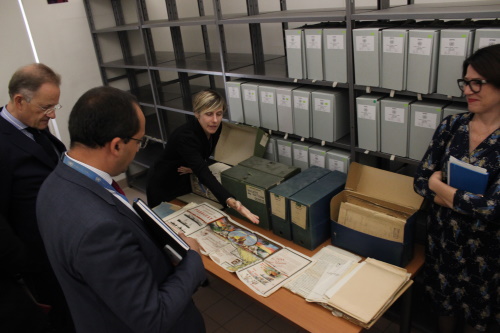100 years of multilateralism
Created in 1919, the League of Nations (LON) was the first international organization with a view to develop cooperation among nations and to guarantee them peace and security. In 1920, the League established its seat in Geneva.
The LON archives (1920-1946) are a critical resource to those examining the development of multilateral diplomacy and international relations. The past 20 years have seen an explosion of use of the archives in a range of international historical research and a significant reevaluation of the League itself.
Preserving the Memory of the World
From the moment the LON Archives became part of the UNESCO Memory of the World Register, in 2009, the archivists at the UN Geneva – who had inherited not only the LON paper archives but also the responsibility to preserve them – began looking for opportunities to make this unique material more easily accessible for the current and next generations of researchers.
In 2017, with the support of a grant from a private Geneva foundation, a massive five-year project called the ‘Total Digital Access to the League of Nations Archives Project’ (LONTAD) was launched, with four primary objectives:
- Digitize the entirety of the LON Archives.
- Provide online access.
- Improve the physical preservation of the collection.
- Provide for the long-term digital preservation of the products produced by the project.
The LONTAD project represents an enormous undertaking and economic investment. We could not risk that one day the digitized material produced by the project could be lost or become unusable. For that reason, the implementation of a Digital Preservation system to ensure the long-term preservation of and access to the digital copies of the LON Archives was included from the beginning as an essential part of the project.
When the project started, there was no Digital Preservation system in place in the Organization.
A significant advocacy effort was made among senior managers at UN Geneva, including IT services, to convince them of the necessity of implementing a robust, long-term digital preservation solution as part of the project.

The project
The effort to provide long-term preservation of the League of Nations Archives is a large scale and successful project that will ensure digital and physical preservation and state-of the-art free online access to around 15 million pages, or almost three linear kilometers, of archival documents of the League of Nations.
By structuring our preservation system as a catalogue, utilizing multi-representation assets, and creating automated processes using APIs, this project was been delivered at scale and under tight time pressures.
Key project considerations & outcomes:
Cost - Because the data is stored in the cloud, we can make use of the different levels oftiered storage to minimise long term storage costs. Access copies of digitized documents generated a multi-page PDF document, these are stored on low latency AWS S3 for immediate access. High-quality JPG2000 images which will be infrequently accessed and make up around 80% of the storage volume are stored on low cost AWS Glacier.
Structure - The digitized documents created are, by definition, complex assets; they contain multiple representations for both long term preservation and access. Each representation contains different numbers of objects, for example the access representation is a single multi-page PDF document and the preservation representation consists of multiple JPG2000 images (one for each page). The information objects are generated and can be held within the preservation system using their original structure without change.
Metadata - The descriptive metadata describing each digitized document has been taken from the League of Nations archival management system (AMS) and attached to each information object within the Preservation system. This way the descriptions are fully searchable and can be presented to researchers and the public through the discovery portal.
Scalable - We have ingested around 110TB of digital data (90,000 boxes of documents andover 6 million digital files) into our preservation system over a 6-month period. This could only be achieved by automating the process and eliminating the manual steps from the ingest workflow. We have made extensive use of the Preservica APIs for both updating information on the repository and automating the submission of data. During the ingest phase we were sending around 1TB of digital content to Preservica every day and ingesting around 90,000 digital objects per day.
Discoverability - The League of Nations have gone to great lengths to create OCR information from the historic documents. This information has been embedded into the access PDF document during the scanning process and extracted by Preservica during ingest to provide a full text index to allow users to search and discover information inside documents.
Access - As the LON data has now become public, this extensive archive will become available to the public through an access portal connected directly to the preservation system. This will give researchers and the public the ability to access and find information on some of the key moments from the 20th century.
The future
We are finalizing the selection of a new AMS that will be synchronized with Preservica, eliminating the need to export the metadata from the catalogue.
Today the files are available to researchers upon request through the Preservica ‘Universal Access’ interface, as a temporary solution until the final access portal will be implemented. This decision was made in the context of COVID-19 and has allowed the archives to continue delivering professional services to our users while in-person consultation remains prohibited or severely restricted.
The LON paper archives have survived for 100 years. It is now our responsibility to preserve the digital copies for the next generations of researchers: preserving the past, by using today’s technology, as we look to the future.






























































































































